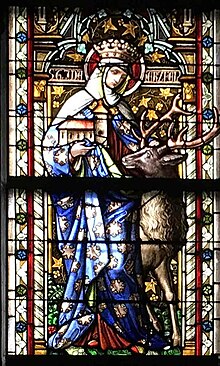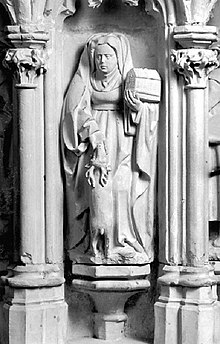Ida von Herzfeld
Ida von Herzfeld (Saint Ida von Herzfeld) (* around 770/775; † 825 ) was a German church donor and is venerated as a saint within the Catholic Church , especially in Germany .
origin
The origin of Ida is controversial in historical studies. It is agreed that she was closely related to the Carolingians .
According to one opinion, Ida is seen as the daughter of Abbess Theodrada von Soissons (sister of Abbots Adalhard and Wala ), a granddaughter of Karl Martell (through his son Bernhard). In this variant, the father is Count Theodoric, son of the last Merovingian king Childerich III. called. According to another opinion, Ida would have been Karlmann's daughter , brother of Charlemagne , and his wife Gerperga . Both views lead to the fact that Ida, as Karl Martell's granddaughter or great-granddaughter, was closely related to Charlemagne on the sidelines.
According to a lesser opinion that is not substantiated in the literature, Ida would have been the daughter of Karlmann's widow Gerperga and an unknown Frankish count. According to this, she would have no family connection to the Carolingians.
Life
After her marriage to the Saxon Duke Ekbert (from the Ekbertiner family ), she left her home and moved with him to Westphalia in 786 to his estates, which were near the present-day city of Osnabrück . On the way there, they crossed the Lippe on a ford near Hirutveldun (Old Saxon: deer fields) and pitched their tent on the right bank of the river. The following night, in a dream, Ida received the order from an angel to build a church there. This dream vision determined her actions and thoughts from now on. She struggled to build a house of God and thus became the founder of the first Catholic parish in Münsterland in today's Herzfeld (Lippetal) .
The trip to Westphalia coincided with the 32-year war between the Saxons and the Franks . During this time Ida took the Saxons under their protection. The deer , with which Ida is often depicted, is a picture for the Saxons oppressed by the Franks. The stag is still on the Herzfeld coat of arms today.
Ekbert died in 811. He found his final resting place on the south side of the church. A portico was built over the grave , where Ida lived after Ekbert's death. There, in the immediate vicinity of the altar , Ida devoted herself entirely to prayer and care for the community. The stone coffin served as a chest for the gifts that, according to legend, she should have given out twice a day to the needy. Ultimately, the activities described cannot be proven historically.
Ida died on September 4, 825. The portico with her grave became the first pilgrimage site in Westphalia. Some of her bones were temporarily brought to the Werden Abbey near Essen , which was owned by the church founded by Ida.
A daughter of Ida, Ida the Younger, was married to Asig , namesake of the Esikonen family , who ruled as counts in the Hessengau .
Adoration
On November 26th, 980, Bishop Dodo von Munster raised Ida's bones in honor of the altars. The life story of Ida ( Vita sanctae Idae Hertzfeldensis ), which the monk Uffing of the Werden Abbey wrote in 980 on the occasion of her translation , focuses - as is customary in the life of saints in the Middle Ages - her chosen god and her exemplary life including the sufferings endured in trust in God; it is more a guide to Christian discipleship than a biography in the modern sense. The development of popular saints contributed to the creation of legends.
Remembrance day in the Catholic Church is September 4th .
To this day, Catholics consider Ida to be the patron saint of pregnant women, the poor and the weak. The sarcophagus , the shrine with its relics and the remains of the church she built can be seen in the grave crypt of the pilgrimage church of St. Ida (since October 2011 the papal pilgrimage basilica ) in Herzfeld. Pilgrimages to the Ida shrine continue to this day. In Herzfeld every year in September the "Ida week" is held in memory of the saint as a folk festival. This week the bones of the saints are carried through the town in a solemn procession as part of the so-called “Identracht”. Then the “Ida blessing” is given.
Namesake
In North Rhine-Westphalia - besides St. Ida in Herzfeld - a few other catholic houses of worship bear their names, for example in Gelsenkirchen-Resser Mark (now Ecumenical Center St. Ida), in Moers and in Münster- Gremmendorf . A Catholic primary school was named after her in Herzfeld and Münster .
literature
- Norbert Colmar: Ida von Herzfeld. In: Biographisch-Bibliographisches Kirchenlexikon (BBKL). Volume 2, Bautz, Hamm 1990, ISBN 3-88309-032-8 , Sp. 1249-1250.
- Eduard Hlawitschka : To the origin of the Liudolfinger and to some Corveyer historical sources . In: Rheinische Vierteljahrsblätter , Jg. 38 (1974), pp. 92–165, here p. 147 ff.
- Gabriele Isenberg: Heiligenleben as a source of history: a difficult approach. The Ida von Herzfeld case . In: Westfälische Zeitschrift , vol. 162 (2012), pp. 23–43.
- Franz Josef Jakobi: On the question of the descendants of St. Ida and the reorientation of the Saxon nobility in the Carolingian era . In: Géza Jászai (ed.): Saint Ida von Herzfeld 980–1980. Festschrift for the millennial return of the canonization of St. Ida von Herzfeld . Municipality of Lippetal-Herzfeld / Landschaftsverband Westfalen-Lippe, Herzfeld / Münster 1980, pp. 53–63.
Web links
- Medieval genealogy - Saint Ida von Herzfeld ( Memento from April 15, 2008 in the Internet Archive )
Individual evidence
-
↑ See the disputes presented below and their sources:
- Eduard Hlawitschka: To the origin of the Liudolfinger and to some Corveyer historical sources . In: Rheinische Vierteljahrsblätter , Jg. 38 (1974), pp. 92–165, here p. 147 ff.
- Franz Josef Jakobi: On the question of the descendants of St. Ida and the reorientation of the Saxon nobility in the Carolingian era . In: Géza Jászai (ed.): Saint Ida von Herzfeld 980–1980. Festschrift for the millennial return of the canonization of St. Ida von Herzfeld . Herzfeld / Münster 1980, pp. 53-63.
- Wilhelm Schneider: Paderborn and the Liesborn Abbey. Charlemagne as a co-founder? - Relatives of St. Ida . In: Jahrbuch Westfalen , Vol. 40 (1986), pp. 120–125.
- ↑ For example Augustin Hüsing: The Genealogy of St. Ida . In: Journal for patriotic history and antiquity , vol. 38 (1880), p. 10; Hans-Walter Krumwiede: The Fischbeck Abbey on the Weser. Studies on Early History 955–1158 . Vandenhoeck & Ruprecht, Göttingen 1955, pp. 49, 51, 53, 56.
- ↑ Eduard Hlawitschka: To the origin of the Liudolfinger and to some Corveyer historical sources . In: Rheinische Vierteljahrsblätter , Jg. 38 (1974), pp. 92–165, here p. 147 ff.
- ↑ Clemens Hillmann: The church and burial place of St. Ida von Herzfeld . Published by the Catholic parish of St. Ida Herzfeld, dcv druck Werl, 2nd expanded and updated edition 2003.
- ↑ David Joseph Collins: Chorography and Hagiography: Johannes Cincinnius's Revision of Uffing's Vita s. Idae Hertzfeldensis . In: Gabriela Signori (ed.): "Holy Westphalia". Saints, relics, pilgrimage and miracles in the Middle Ages . Publishing house for regional history, Bielefeld 2003, ISBN 3-89534-491-5 , pp. 211-236.
- ↑ Peter Ilisch: The popular worship of St. Ida in Westphalia before 1800 . In: Géza Jászai (ed.): Saint Ida von Herzfeld 980–1980. Festschrift for the millennial return of the canonization of St. Ida von Herzfeld . Municipality of Lippetal-Herzfeld / Landschaftsverband Westfalen-Lippe, Herzfeld / Münster 1980, pp. 146–149.
- ^ Géza Jászai: Iconographic remarks on the Ida cult in Westphalia . In the S. (Ed.): Saint Ida von Herzfeld 980–1980. Festschrift for the millennial return of the canonization of St. Ida von Herzfeld . Municipality of Lippetal-Herzfeld / Landschaftsverband Westfalen-Lippe, Herzfeld / Münster 1980, pp. 108-136.
- ↑ The Soester Anzeiger on the Great Identracht 2015 in Herzfeld , published on September 13, 2015, accessed on June 4, 2017.
| personal data | |
|---|---|
| SURNAME | Ida von Herzfeld |
| ALTERNATIVE NAMES | Holy Ida |
| BRIEF DESCRIPTION | German founder of the order |
| DATE OF BIRTH | at 770 or at 775 |
| DATE OF DEATH | 825 |


